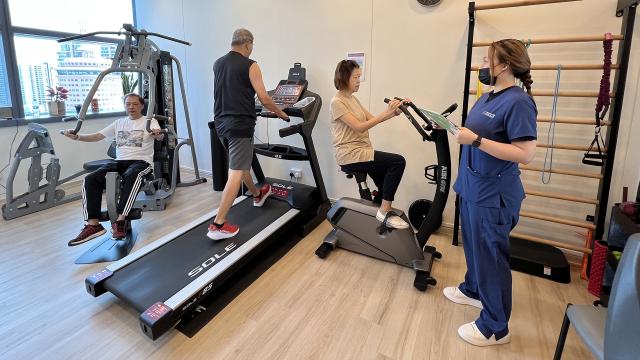Dr Barbara Bichelmeyer, Provost and Executive Vice Chancellor of the University of Kansas, spoke at the Applied Learning Conference 2023 and shared why the future of education lies in competency-based education.
Dr Barbara Bichelmeyer, Provost and Executive Vice Chancellor of the University of Kansas, speaking at the Applied Learning Conference 2023. (Photo: SIT)
We are undergoing a change to education “that’s as big as the printing press.” Much like how mass media has undergone a transformation from print in newspapers and magazines to digital media platforms, education is experiencing the same revolution, said Dr Barbara Bichelmeyer, Provost and Executive Vice Chancellor of the University of Kansas.
“When there wasn’t the internet, when textbooks cost a lot of money, we defined expertise as what you know,” Dr Bichelmeyer explained. “And so, our response to that was to disseminate information.”
Lectures became the focus of higher education. But in today’s internet age, where information is at the fingertips of every individual, the need for information dissemination through lectures is waning.
So, what value do educational institutions provide if not information dissemination? Dr Bichelmeyer suggests that their role today is no longer to be a “sage on a stage”, but rather a “guide on the side”.
“It is providing engaging educational experiences; it is implementing high-impact practices where we work with students on applying issues, teaching them how to think the way a scholar, business manager or whatever-the-title-is that we're working towards,” she said.
“For all those reasons, I believe that the future of education is competency-based,” said Dr Bichelmeyer during her keynote address at the Applied Learning Conference 2023, organised by the Singapore Institute of Technology.
What is Competency-based Education?
Competency-based education (CBE) is different from traditional education in a couple of ways, according to Dr Bichelmeyer.
“First, it’s about rethinking the relationship between outcomes and time,” she said. Traditional education tends to hold time as the constant factor, and lets the outcome of this educational experience vary, she explained. Students have a fixed amount of time to learn the required materials before they are assessed, and their grades are then determined based on their mastery of these materials in a specified timeframe.
But competency-based education flips the script, she said. It holds outcomes constant instead, ensuring that all students have fully mastered the skills they had set out to learn before moving on.
Next, CBE calls for a greater emphasis on “verbs” instead of “nouns”, according to Dr Bichelmeyer. Nouns here refer to the subject matter, such as the study of philosophy, biology, languages, and so on. Meanwhile, verbs emphasise the cognitive skills and the structured ways of thinking in a discipline, she explained.
For instance, in a CBE curriculum of a history course, the learning objective might be to teach students the skill of archival analysis instead of understanding what happened in the second world war.
“Expertise is no longer what you know, but it’s what you do with what you know,” said Dr Bichelmeyer. “We need cognitive skills and structured ways of thinking to navigate this sea of information and misinformation that we are now experiencing.”
That is not to say that a CBE curriculum will no longer teach subject matter expertise. “CBE is simply shifting the relative focus and prioritisation of subject matter, so that we clarify cognitive skills and competencies and privilege them in the educational experience,” Dr Bichelmeyer clarified.
Implementation Begins at the End
To implement competency-based education, Dr Bichelmeyer suggests an approach known as “backward design” – prioritising learning goals of the curriculum instead of being fixated on topics to be covered. Faculty need to first understand what the learning outcomes are – what do students need to be able to do as a result of their educational experience? And what helps them become ready for a career?
“It’s prioritising these cognitive skills over subject matter, and then putting the subject matter in place,” she explained. For instance, an English faculty could have a module on teaching students to write and evaluate an argument. As long as students can successfully execute the skill of writing and evaluation at the end of the course, the subject matter becomes secondary.
At the University of Kansas, for example, the English faculty uses the topic of werewolves to teach these skills, as she shared that it’s a subject matter that piques students’ interest.
Following the backwards design method, Dr Bichelmeyer also emphasised that the outcomes institutions set should serve as a baseline rather than a target or goal. “[Students] will always learn different things in varying degrees. You want to know, at least, that they will learn the skill that you need them to walk away with,” she explained.
Once faculty have planned out the outcome of their courses, they then need to consider how to measure these outcomes. This could take the form of a pre-test before the course begins. This can subsequently be followed by an assessment at the end of the course so students can demonstrate that they have met the learning outcomes, she explained.For CBE to succeed, Dr Bichelmeyer recommended that educational institutions make a concerted effort for faculty development and support. The University of Kansas, for example, is providing support in terms of instructional designers, instructional technologists and assessment specialists to equip faculty members with the skills they need to ‘backward-design’ a course.

Faculty must be supported with skills and resources to backward-design a course that is learning-focused and learner-centric. (Photo: Shutterstock)
What's in it for Industry?
During her keynote, Dr Bichelmeyer highlighted how her former company, Sprint, would spend millions of dollars placing fresh graduates in two-month boot camps to teach them the skills they needed for the job.
“Sprint didn't want to be doing that,” she said. “They needed to do that because higher education institutions weren't making that connection for them.”
“If the skills needed for an academic credential in engineering aren’t what engineers need to do on the job, we have a major disconnect,” she illustrated.CBE, in this instance, serves as the bridge between education and industry by articulating the cognitive skills that jobs call for, and equipping individuals with those relevant skills. “What CBE does best is [that] it claims and validates competencies against or across stakeholder groups that need something from education,” she explained.

CBE articulates the cognitive skills that jobs require and equips individuals with those specific, relevant skills. (Photo:SIT)
This leads to a level of alignment previously unseen in the education sector.
Successful implementation of CBE would be a “win” for all stakeholders involved: students, faculty members, employers, as well as society at large, said Dr Bichelmeyer.
She explained that students “win” as they derive true value from their education, while faculty members draw fulfilment from successfully delivering relevant and essential education.
At the same time, employers are not spending excessive resources and dollars on training and re-training their staff. Society benefits as talents enter the workforce with relevant skills and knowledge.
CBE is to education what the notable space telescope Copernicus was to astronomy, suggested Dr Bichelmeyer. It provides the sector with the tools that allow it to see farther and reach further than was previously possible, she concluded.
This article was first published in GovInsider.
![[FA] SIT One SITizen Alumni Initiative_Web banner_1244px x 688px.jpg](/sites/default/files/2024-12/%5BFA%5D%20%20SIT%20One%20SITizen%20Alumni%20Initiative_Web%20banner_1244px%20x%20688px.jpg)


